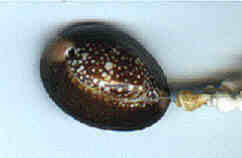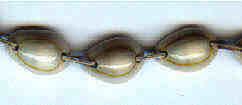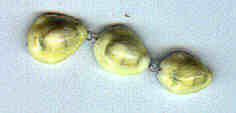Your path =Home>Beadmaking & Materials>Organic Materials> Beads and Seashells
Cowries
Just the names for this shell have interesting stories to tell. The English word comes from the Hindi kauri, widely used for seashells in general. In turn, the Hindi word is from Sanskrit, the "mother language" of Hindi, but its real origin is from a Dravidian language of South India unrelated to either Hindi or Sanskrit.
|
But that's not the end of it. When Marco Polo saw them in use he called them porcellana, an Italian word meaning "little pigs" because of their general shape. When Chinese ceramics began to be imported into Europe, their smooth, polished white surfaces reminded people of the little pigs, and eventually the ceramics came to be called porcelain.
Cowries have been used for beads for millennia. They are found in Neolithic China (as at Banpo) and real and imitation cowries were used in China as beads and money for thousands of years. Cowry beads made of gold were worn in ancient Egypt (see here). Nor is it an accident that our word comes from Indian languages. Cowries were used for small change in Bengal for longer than anyone knows. Arab traders (not Europeans) introduced them to East Africa, from which they reached West Africa before European traders.
They were used for money as well as charms.
|
The magical use of cowries revolves around one of two uses. They are considered powerful in ensuring female fertility. They are also thought effective against the Evil Eye (see here) because of their general eye shape. In Iran they are called "eye crackers."
Last Gallery PageNext Gallery Page
__________________________________________________
Small Bead Businesses | Beading & Beadwork | Ancient Beads | Trade Beads
Beadmaking & Materials | Bead Uses | Researching Beads | Beads and People
Center for Bead Research | Book Store | Free Store | Bead Bazaar
Shopping Mall | The Bead Auction | Galleries | People | Events
The Bead Site Home | Chat Line | Contact Us | Site Search Engine | FAQ


